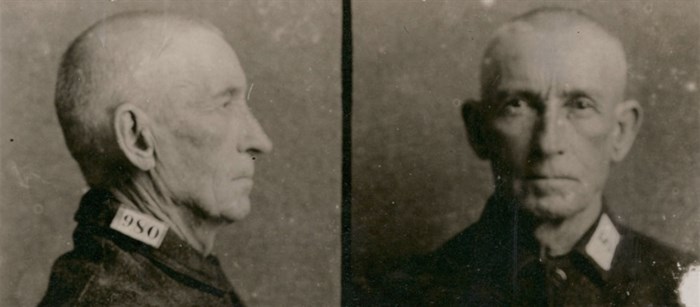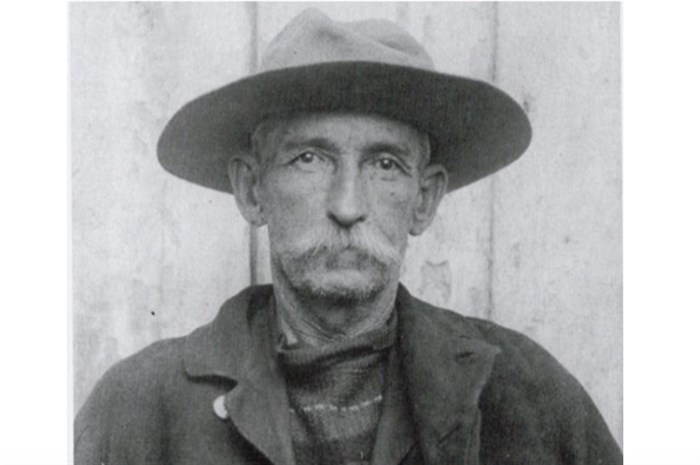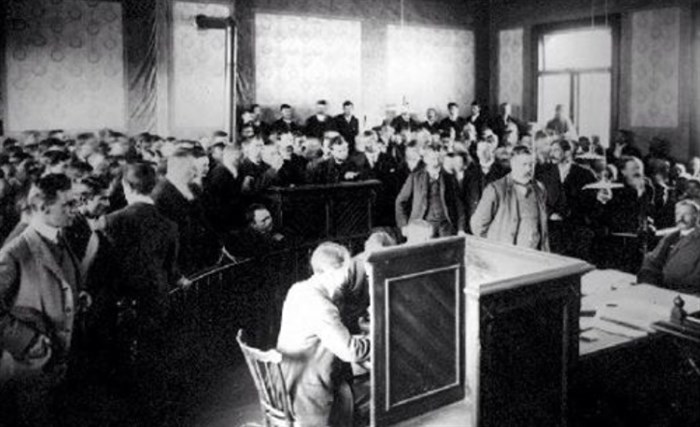
Bill Miner is pictured in his mugshot upon his arrival at B.C. Penitentiary in New Westminster.
Image Credit: SUBMITTED- Co Lab Library and Archives
September 16, 2019 - 7:00 AM
KAMLOOPS - We commemorate all kinds of things in B.C. but this one’s a little different.
A sign installed at the B.C. Wildlife Park in Kamloops brings attention to the life of Bill Miner but it’s not for community-building or heroism or achievements. Miner is only known for heists, robbing trains and escaping prisons.
And by all accounts, he was very good at it.
The infamous American bandit, who orchestrated the first hold-up on the Canadian Pacific Railway, is recognized in these parts because he stood trial in Kamloops and by that time he was one of the most well-known outlaws of the late 1800s and early 1900s.
Miner was known as the “Gentleman Bandit,” and “Grey Fox” due to his polite manner during robberies. He may also be first to use the phrase “Hands up!”
Born in 1842, Miner stood 5’ 8.5”, weighed 138 pounds, and sported grey hair on his head and his face when he was arrested in 1906, according to Library and Archives Canada records from his arrest. The records show he was sentenced to life in prison, but this would be a short story if that happened.
Before trying his luck in B.C., Miner was a thief across the United States, stopped his first train and first arrested before he was 17, stealing from homes, trains, and even stealing livestock, according to a 1958 article in The Province newspaper.

After his arrest for the train robbery near Kamloops, photographer Mary Spencer took his portrait.
Image Credit: FACEBOOK - Kamloops History
He spent nearly half of his life behind bars before he was released from San Quentin prison in 1901 at the age of 55.
He moved to B.C. in 1904 and took on the alias George Edwards. It is reported in the History Link encyclopedia that he worked with a man named Jake Terry, smuggling undocumented Chinese immigrants and opium into the United States. Terry had a good understanding of railway operations, and he and Miner made a plan to hold up the Canadian Pacific Railway near Mission. That heist brought them $1,000 in cash, $6,000 in gold dust, $50,000 of U.S. government bonds and $250,000 in negotiable Australian securities. The gold dust and money was the only thing of value to the men, and they decided to hide the $300,000 of securities. Eventually, Terry tried to return the securities for a finders fee but was not awarded any money.
He was brought down by a man named W.R. Nelems who worked on railroads in Chilliwack and sat down to breakfast with Miner and Terry after they the train robbery. After Miner’s arrest, he sent a letter to the prison describing his interaction with Miner.
“I was a commission agent at Chilliwack for the Dominion Express Co. and C.P.R. tickets, and at 7 a.m. in the fall of 1906, on the morning that Bill Miner and his two associates robbed to C.P.R. train 4 and a half miles east of Mission, on the mainline of the C.P.R., I sat down to breakfast with them at the old Dominion Hotel, Chilliwack, not knowing of course that they were the train robbers,” Nelems said in a letter to the warden of the B.C. Penitentiary in New Westminster.
Although a reward was issued for the capture of the criminals, Miner was not caught. On May 8 1906, Miner and a gang of bandits held up the Canadian Pacific Railway again, this time near what is now known as Monte Creek, just east of Kamloops. The robbery was unsuccessful, bringing them only $15 and some liver pills, according to the Canadian Encyclopedia. Instead, Miner and two of his associates were arrested in Douglas Lake and brought back to Kamloops to be tried.
Miner was sentenced to life in the B.C. Penitentiary in New Westminster, but again — he had other plans.

This photo captures Bill Miner as he is tried in a Kamloops court.
Image Credit: FACEBOOK - Kamloops History
Miner escaped from B.C. Penitentiary on Aug 8, 1907 and an article published in Vancouver World the next day describes the details of his escape. Although those sentenced to life were usually kept confined, an apparent illness allowed him to work in the outdoor brickyard. Due to recent repairs, he knew the fence of the enclosure went only six to ten inches into the ground. He took advantage of a short-staffing issue and the high cover provided by some of the brick piles. The article states Miner shared his plan for escape with three other men, known as Clusky, Clarke, and Woods. By digging a little bit each day, the group eventually created a tunnel. When they escaped, they brought a pick and shovel, which they used to break a padlock holding a ladder. The men were quickly over the second wall and made a run for it. They escaped at 4:30 in the afternoon, and although guards followed their footsteps, they couldn’t locate the men that night.
George Des Rochers, a farmer who lived on Nicomen Island near Chilliwack, recognized Miner after his photo was shared in a newspaper, and reported to police that he had fed Miner after his escape.
According to an article in the Daily News on Aug. 14 of 1907, a weary Miner approached the farmer and asked him if he had seen a horse wander by. Miner said he had been looking for the horse since 4 a.m. and asked to have a meal.
“He got away with five cups of coffee, a whole loaf of bread, three pounds of cold meat, and nearly half a jar of preserves,” Rochers said.
A reward of $500 was issued for Miner’s recapture. R.G. Chamberlain, Chief of Police in Vancouver, wrote a letter to the Inspector of Penitentiaries noting that no friend of Miner’s would give him up for such a small amount. Chamberlain offered assistance from their department, although not much, to aid in his rearrest.
He wasn't caught after his escape from the New Westminster prison. Instead, Miner made his way back to the United States and lived a relatively quiet life until 1911, when he robbed a train in Georgia.
According to a publication by History Link, he got away with $2,000 but was caught soon after and sentenced to 20 years in a Georgia prison. He escaped twice and was caught both times. During one of the escapes, a boat he stole capsized in a swamp. Miner struggled and ingested some of the swamp water, which led to a case of gastritis.
He died from the condition a year later on September 2, 1913, and was buried in an unmarked grave. More than 50 years later, a historian placed a headstone on the grave that reads “Bill Miner- the Last of The Famous Western Bandits.”
A movie commemorating the life of Miner was released in 1982. Titled “The Grey Fox,” the biographical tale followed Miner's criminal life journey.
To contact a reporter for this story, email Jenna Wheeler or call (250) 819-6089 or email the editor. You can also submit photos, videos or news tips to the newsroom and be entered to win a monthly prize draw.
We welcome your comments and opinions on our stories but play nice. We won't censor or delete comments unless they contain off-topic statements or links, unnecessary vulgarity, false facts, spam or obviously fake profiles. If you have any concerns about what you see in comments, email the editor in the link above.
News from © iNFOnews, 2019